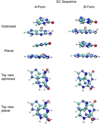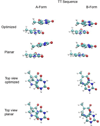Impact of geometry optimization on base-base stacking interaction energies in the canonical A- and B-forms of DNA
- PMID: 23343365
- PMCID: PMC3579007
- DOI: 10.1021/jp308364d
Impact of geometry optimization on base-base stacking interaction energies in the canonical A- and B-forms of DNA
Abstract
Base stacking is known to make an important contribution to the stability of DNA and RNA, and accordingly, significant efforts are ongoing to calculate stacking energies using ab initio quantum mechanical methods. To date, impressive improvements have been made in the model chemistries used to perform stacking energy calculations, including extensions that include robust treatments of electron correlation with extended basis sets, as required to treat interactions where dispersion makes a significant contribution. However, those efforts typically use rigid monomer geometries when calculating the interaction energies. To overcome this, in the present work, we describe a novel internal coordinate definition that allows the relative, intermolecular orientation of stacked base monomers to be constrained during geometry optimizations while allowing full optimization of the intramolecular degrees of freedom. Use of the novel reference frame to calculate the impact of full geometry optimization versus constraining the bases to be planar on base monomer stacking energies, combined with density-fitted, spin-component scaling MP2 treatment of electron correlation, shows that full optimization makes the average stacking energy more favorable by -3.4 and -1.5 kcal/mol for the canonical A and B conformations of the 16 5' to 3' base stacked monomers. Thus, treatment of geometry optimization impacts the stacking energies to an extent similar to or greater than the impact of current state of the art increases in the rigor of the model chemistry itself used to treat base stacking. Results also indicate that stacking favors the B-form of DNA, though the average difference versus the A-form decreases from -2.6 to -0.6 kcal/mol when the intramolecular geometry is allowed to fully relax. However, stacking involving cytosine is shown to favor the A-form of DNA, with that contribution generally larger in the fully optimized bases. The present results show the importance of allowing geometry optimization, as well as properly treating the appropriate model chemistry, in studies of nucleic acid base stacking.
Figures







Similar articles
-
Toward true DNA base-stacking energies: MP2, CCSD(T), and complete basis set calculations.J Am Chem Soc. 2002 Oct 2;124(39):11802-8. doi: 10.1021/ja026759n. J Am Chem Soc. 2002. PMID: 12296748
-
Comparison of intrinsic stacking energies of ten unique dinucleotide steps in A-RNA and B-DNA duplexes. Can we determine correct order of stability by quantum-chemical calculations?J Phys Chem B. 2010 Jan 21;114(2):1191-203. doi: 10.1021/jp910788e. J Phys Chem B. 2010. PMID: 20000584
-
True stabilization energies for the optimal planar hydrogen-bonded and stacked structures of guanine...cytosine, adenine...thymine, and their 9- and 1-methyl derivatives: complete basis set calculations at the MP2 and CCSD(T) levels and comparison with experiment.J Am Chem Soc. 2003 Dec 17;125(50):15608-13. doi: 10.1021/ja036611j. J Am Chem Soc. 2003. PMID: 14664608
-
Calculations on noncovalent interactions and databases of benchmark interaction energies.Acc Chem Res. 2012 Apr 17;45(4):663-72. doi: 10.1021/ar200255p. Epub 2012 Jan 6. Acc Chem Res. 2012. PMID: 22225511 Review.
-
Aromatic Base Stacking in DNA: From ab initio Calculations to Molecular Dynamics Simulations.J Biomol Struct Dyn. 2000;17 Suppl 1:1-24. doi: 10.1080/07391102.2000.10506597. J Biomol Struct Dyn. 2000. PMID: 22607400 Review.
Cited by
-
A unified computational view of DNA duplex, triplex, quadruplex and their donor-acceptor interactions.Nucleic Acids Res. 2021 May 21;49(9):4919-4933. doi: 10.1093/nar/gkab285. Nucleic Acids Res. 2021. PMID: 33893806 Free PMC article.
-
Non-Covalent Molecular Interaction Rules to Define Internal Dimer Coordinates for Quantum Mechanical Potential Energy Scans.J Comput Chem. 2025 May 30;46(14):e70136. doi: 10.1002/jcc.70136. J Comput Chem. 2025. PMID: 40377454 Free PMC article.
-
Polarizable Force Field for DNA Based on the Classical Drude Oscillator: I. Refinement Using Quantum Mechanical Base Stacking and Conformational Energetics.J Chem Theory Comput. 2017 May 9;13(5):2053-2071. doi: 10.1021/acs.jctc.7b00067. Epub 2017 Apr 19. J Chem Theory Comput. 2017. PMID: 28399366 Free PMC article.
-
Polarizable force field for RNA based on the classical drude oscillator.J Comput Chem. 2018 Dec 15;39(32):2624-2646. doi: 10.1002/jcc.25709. J Comput Chem. 2018. PMID: 30515902 Free PMC article.
-
Balancing the interactions of ions, water, and DNA in the Drude polarizable force field.J Phys Chem B. 2014 Jun 19;118(24):6742-57. doi: 10.1021/jp503469s. Epub 2014 Jun 9. J Phys Chem B. 2014. PMID: 24874104 Free PMC article.
References
-
- Olson WK, Zhurkin VB. Current Opinion in Structural Biology. 2000;10:286–297. - PubMed
-
- Ivanov VI, Krylov DY. Methods Enzymol. 1992;211:111–127. - PubMed
-
- Franklin RE, Gosling RG. Nature. 1953;171:740–741. - PubMed
-
- Pohl FM, Jovin TM. J. Mol. Biol. 1972;67:375–396. - PubMed
-
- Leslie AGW, Arnott S, Chandrasekaran R, Ratliff RL. J. Mol. Biol. 1980;143:49–72. - PubMed
Publication types
MeSH terms
Substances
Grants and funding
LinkOut - more resources
Full Text Sources
Other Literature Sources

